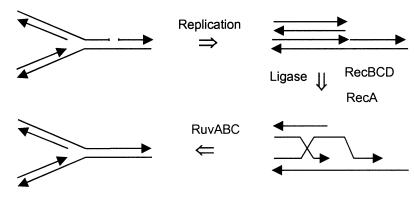FIG. 2.
Model for the generation of double-strand breaks in dam bacteria (8, 11). A replication fork approaches a nick releasing a chromosomal arm the end of which becomes a substrate for RecBCD action. The 3′ single strand thus produced is made to synapse by RecA to produce a Holliday junction that can be processed by RuvABC. Resolution of the Holliday junction restores the replication fork. See the work of Kuzminov (11) for further details of this model.

